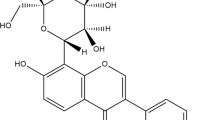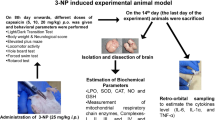Abstract
Systemic administration of kainic acid (KA) in rodents triggers limbic seizures following selective neuronal loss in the hippocampus attributed to the excitotoxic process. Lipid peroxidation products, such as 4-hydroxynonenal, are produced by oxidative stress and are present on the hippocampus, which contribute to neuronal death in the KA excitotoxicity model. Several antioxidants are neuroprotective agents. The aim of the present study was to analyse whether pirfenidone (PFD, 5-methyl-1-phenyl-2-(1H)-pyridone), an antioxidant drug, protects the neurons in the hippocampus of pubescent rats administered with KA. We evaluated the neuroprotective effect of PFD by quantifying the surviving neurons under hematoxilin-eosin staining after using three different doses of 100, 250, and 325 mg/kg administered via an orogastric tube 90 min after KA intraperitoneal injection (12 mg/kg). Only 325 mg/kg of PFD-attenuated neuronal loss in the hippocampal areas cornu ammonis field 1 (CA1) and cornu ammonis field 3 (CA3c) was observed; therefore, this dose was used in our subsequent studies. Later, we established that PFD reduces neuronal degeneration using Fluoro-Jade B stain in the CA3c but not in the CA1, and PFD reduces the presence of 4-hydroxynonenal, a lipid peroxidation product, in the CA3 by tissue immunohistochemistry. We concluded that only a single 325 mg/kg PFD dose had a neuroprotective effect after KA brain injury. This treatment may be advantageous because adequate pharmacological therapy with PFD can be developed to protect the neuron even after an acute neuronal disorder such as seizures or hypoxic/ischemic damage.




Similar content being viewed by others
Abbreviations
- 4-HNE:
-
4-Hydroxynonenal
- KA:
-
Kainic Acid
- PFD:
-
Pirfenidone
- CA1:
-
Cornu Ammonis Field 1
- CA3:
-
Cornu Ammonis Field 3
References
Anderson KJ, Fugaccia I, Scheff SW (2003) Fluoro-Jade B stains quiescent and reactive astrocytes in the rodent spinal cord. J Neurotrauma 20(11):1223–1231
Babovic-Vuksanovic D, Petrovic L, Knudsen BE, Plummer TB, Parisi JE, Babovic S, Platt JL (2004) Survival of human neurofibroma in immunodeficient mice and initial results of therapy with pirfenidone. Biomed Res Int 2004(2):79–85
Ben-Ari Y (1985) Limbic seizure and brain damage produced by kainic acid: mechanisms and relevance to human temporal lobe epilepsy. Neurosci 14(2):375–403
Ben-Ari Y, Cossart R (2000) Kainate, a double agent that generates seizures: two decades of progress. Trends Neurosci 23(11):580–587
Bruce AJ, Baudry M (1995) Oxygen free radicals in rat limbic structures after kainate-induced seizures. Free Radic Biol Med 18(6):993–1002
Cain W, Stuart R, Lefkowitz D, Starnes J, Margolin S, Lefkowitz S (1998) Inhibition of tumor necrosis factor and subsequent endotoxin shock by pirfenidone. Int J Immunopharm 20(12):685–695
Carriedo SG, Yin HZ, Sensi SL, Weiss JH (1998) Rapid Ca2+ entry through Ca2+−permeable AMPA/Kainate channels triggers marked intracellular Ca2+ rises and consequent oxygen radical production. J Neurosci 18(19):7727–7738
Cendes F, Andermann F, Carpenter S, Zatorre RJ, Cashman NR (1995) Temporal lobe epilepsy caused by domoic acid intoxication: evidence for glutamate receptor-mediated excitotoxicity in humans. Ann Neurol 37(1):123–126
Choi DW (1992) Excitotoxic cell death. J Neurobiol 23(9):1261–1276
Chung SY, Han SH (2003) Melatonin attenuates kainic acid–induced hippocampal neurodegeneration and oxidative stress through microglial inhibition. J Pineal Res 34(2):95–102
Contractor A, Mulle C, Swanson GT (2011) Kainate receptors coming of age: milestones of two decades of research. Trends Neurosci 343(3):154–163
Damjanac M et al (2007) “Fluoro-Jade® B” staining as useful tool to identify activated microglia and astrocytes in a mouse transgenic model of Alzheimer's disease. Brain Res 1128:40–49
Dingledine R, Borges K, Bowie D, Traynelis SF (1999) The glutamate receptor ion channels. Pharmacol Rev 51(1):7
Esterbauer H, Schaur RJ, Zollner H (1991) Chemistry and biochemistry of 4-hydroxynonenal, malonaldehyde and related aldehydes. Free Radic Biol Med 11(1):81–128
Fujiki M, Kobayashi H, Inoue R, Ishii K (2004) A single oral dose of geranylgeranylacetone attenuates kainic acid-induced seizures and neuronal cell death in rat hippocampus. Brain Res 1021(2):281–285
Golden GT, Smith GG, Ferraro TN, Reyes PF (1995) Rat strain and age differences in kainic acid induced seizures. Epilepsy Res 20(2):151–159
Grattendick K, Nakashima J, Feng L, Giri S, Margolin S (2008) Effects of three anti-TNF-α drugs: etanercept, infliximab and pirfenidone on release of TNF-α in medium and TNF-α associated with the cell in vitro. Int Immunopharmacol 8(5):679–687
Hale ML, Margolin SB, Krakauer T, Roy CJ, Stiles BG (2002) Pirfenidone blocks the in vitro and in vivo effects of staphylococcal enterotoxin B. Infect Immun 70(6):2989–2994
Hazell AS (2007) Excitotoxic mechanisms in stroke: an update of concepts and treatment strategies. Neurochem Int 50(7):941–953
Johnston MV (2005) Excitotoxicity in perinatal brain injury. Brain Pathol 15(3):234–240
Kajitani K, Yamaguchi H, Dan Y, Furuichi M, Kang D, Nakabeppu Y (2006) MTH1, an oxidized purine nucleoside triphosphatase, suppresses the accumulation of oxidative damage of nucleic acids in the hippocampal microglia during kainate-induced excitotoxicity. J Neurosci 26(6):1688–1698
Kang KS, Wen Y, Yamabe N, Fukui M, Bishop SC, Zhu BT (2010) Dual beneficial effects of (−)-epigallocatechin-3-gallate on levodopa methylation and hippocampal neurodegeneration: in vitro and in vivo studies. PloS One 5(8):e11951
Keller JN, Hanni KB, Markesbery WR (1999) 4–hydroxynonenal increases neuronal susceptibility to oxidative stress. J Neurosci Res 58(6):823–830
Kim HC, Jhoo WK, Bing G, Shin EJ, Wie MB, Kim WK, Ko KH (2000) Phenidone prevents kainate-induced neurotoxicity via antioxidant mechanisms. Brain Res 874(1):15–23
Kruman I, Bruce-Keller AJ, Bredesen D, Waeg G, Mattson MP (1997) Evidence that 4-hydroxynonenal mediates oxidative stress-induced neuronal apoptosis. J Neurosci 17(13):5089–5100
Kwon MS, Lee JK, Park SH, Sim YB, Jung JS, Won MH, Kim SM, Suh HW (2010) Neuroprotective effect of visnagin on kainic acid-induced neuronal cell death in the mice hippocampus. Korean J Physiol Pha 14(5):257–263
Liang L, Ho Y, Patel M (2000) Mitochondrial superoxide production in kainate-induced hippocampal damage. Neurosci 101(3):563–570
Macías-Barragán J, Sandoval-Rodríguez A, Navarro-Partida J, Armendáriz-Borunda J (2010) The multifaceted role of pirfenidone and its novel targets. Fibrogenesis Tissue Repair 3:16
McDonald JW, Garofalo EA, Hood T, Sackellares JC, Gilman S, McKeever PE, Troncoso JC, Johnston MV (1991) Altered excitatory and inhibitory amino acid receptor binding in hippocampus of patients with temporal lobe epilepsy. Ann Neurol 29(5):529–541
Mehta A, Prabhakar M, Kumar P, Deshmukh R, Sharma P (2012) Excitotoxicity: bridge to various triggers in neurodegenerative disorders. Eur J Pharmacol 698(1-3):6–18
Mishizen-Eberz AJ, Rissman RA, Carter TL, Ikonomovic MD, Wolfe BB, Armstrong DM (2004) Biochemical and molecular studies of NMDA receptor subunits NR1/2A/2B in hippocampal subregions throughout progression of Alzheimer's disease pathology. Neurobiol Dis 15(1):80–92
Misra HP, Rabideau C (2000) Pirfenidone inhibits NADPH-dependent microsomal lipid peroxidation and scavenges hydroxyl radicals. Mol Cell Biochem 204(1):119–126
Miyamoto R, Shimakawa S, Suzuki S, Ogihara T, Tamai H (2008) Edaravone prevents kainic acid-induced neuronal death. Brain Res 1209:85–91
Nakazato H, Oku H, Yamane S, Tsuruta Y, Suzuki R (2002) A novel anti-fibrotic agent pirfenidone suppresses tumor necrosis factor-α at the translational level. Eur J Pharmacol 446(1):177–185
Nitecka L, Tremblay E, Charton G, Bouillot J, Berger M, Ben-Ari Y (1984) Maturation of kainic acid seizure-brain damage syndrome in the rat. II. Histopathological sequelae. Neuroscience 13(4):1073–1094
Nitta I, Watase H, Tomiie Y (1958) Structure of kainic acid and its isomer, allokainic acid. Nature 181(4611):761–762
Olney JW (1969) Brain lesions, obesity, and other disturbances in mice treated with monosodium glutamate. Science 164(3880):719
Ong W-Y, Lu X-R, Hu C-Y, Halliwell B (2000) Distribution of hydroxynonenal-modified proteins in the kainate-lesioned rat hippocampus: evidence that hydroxynonenal formation precedes neuronal cell death. Free Radic Biol Med 28(8):1214–1221
Patel M, Liang LP, Roberts I, Jackson L (2008) Enhanced hippocampal F2-isoprostane formation following kainate-induced seizures. J Neurochem 79(5):1065–1069
Paxinos G, Watson C (2006) The rat brain in stereotaxic coordinates: hard cover edition. Access Online via Elsevier, ISBN 0080475159
Rasband WS (1997) ImageJ. US National Institutes of Health, Bethesda
Salazar-Montes A, Ruiz-Corro L, Lopez-Reyes A, Castrejon-Gomez E, Armendariz-Borunda J (2008) Potent antioxidant role of pirfenidone in experimental cirrhosis. Eur J Pharmacol 595(1–3):69–77
Schmued LC, Hopkins KJ (2000) Fluoro-Jade B: a high affinity fluorescent marker for the localization of neuronal degeneration. Brain Res 874(2):123–130
Schulz JB, Henshaw DR, Siwek D, Jenkins BG, Ferrante RJ, Cipolloni PB, Kowall NW, Rosen BR, Beal MF (1995) Involvement of free radicals in excitotoxicity in vivo. J Neurochem 64(5):2239–2247
Sensi SL, Yin HZ, Carriedo SG, Rao SS, Weiss JH (1999) Preferential Zn2+ influx through Ca2+ −permeable AMPA/kainate channels triggers prolonged mitochondrial superoxide production. Proc Natl Acad Sci USA 96(5):2414–2419
Shin E-J et al (2011) Role of oxidative stress in epileptic seizures. Neurochem Int 59.2:122–137
Stafstrom CE, Thompson JL, Holmes GL (1992) Kainic acid seizures in the developing brain: status epilepticus and spontaneous recurrent seizures. Dev Brain Res 65(2):227–236
Walker JE, Margolin SB (2001) Pirfenidone for chronic progressive multiple sclerosis. Mult Scler 7(5):305–312
Wang Q, Yu S, Simonyi A, Rottinghaus G, Sun GY, Sun AY (2004) Resveratrol protects against neurotoxicity induced by kainic acid. Neurochem Res 29(11):2105–2112
Xu K, Stringer JL (2008) Antioxidants and free radical scavengers do not consistently delay seizure onset in animal models of acute seizures. Epilepsy Behav 13.1(2008):77–82
Zarkovic K (2003) 4-hydroxynonenal and neurodegenerative diseases. Mol Asp Med 24(4–5):293
Zhang X-M, Zhu J (2011) Kainic acid-induced neurotoxicity: targeting glial responses and glia-derived cytokines. Curr Neuropharmacol 9(2):388
Zhang X, Gelowitz DL, Lai CT, Boulton AA, Yu PH (1997) Gradation of kainic acid-induced rat limbic seizures and expression of hippocampal heat shock protein-70. Eur J Neurosci 9(4):760–769
Zheng XY, Zhang HL, Luo Q, Zhu J (2011) Kainic acid-induced neurodegenerative model: potentials and limitations. J Biomed Biotechnol 2011:457079
Acknowledgments
The present work was supported by grants from Consejo Nacional de la Ciencia y Tecnología (CONACYT No. 0177594 to Carlos Beas-Zárate and No. 298337 to Rubén Darío Castro-Torres).
Conflict of Interest
The authors have declared that no conflict of interest exists.
Author information
Authors and Affiliations
Corresponding author
Rights and permissions
About this article
Cite this article
Castro-Torres, R.D., Chaparro-Huerta, V., Flores-Soto, M.E. et al. A Single Dose of Pirfenidone Attenuates Neuronal Loss and Reduces Lipid Peroxidation after Kainic Acid-Induced Excitotoxicity in the Pubescent Rat Hippocampus. J Mol Neurosci 52, 193–201 (2014). https://doi.org/10.1007/s12031-013-0121-6
Received:
Accepted:
Published:
Issue Date:
DOI: https://doi.org/10.1007/s12031-013-0121-6




